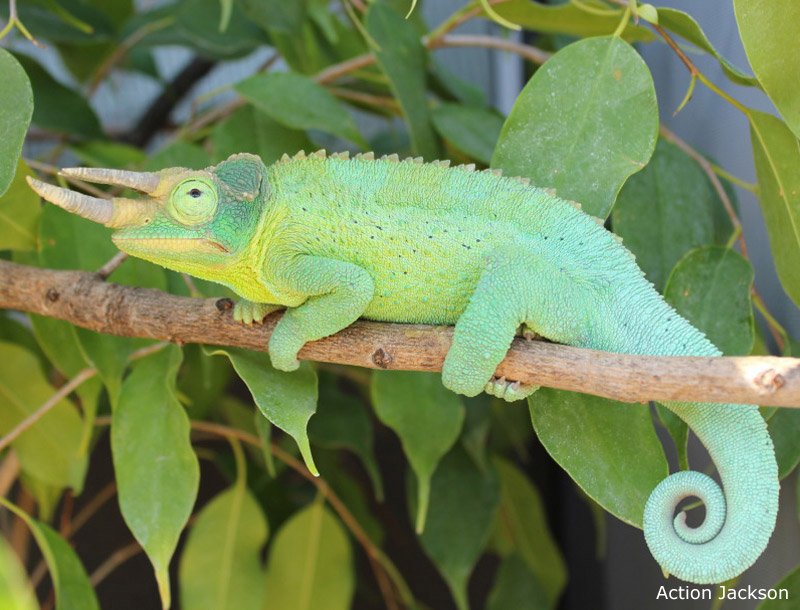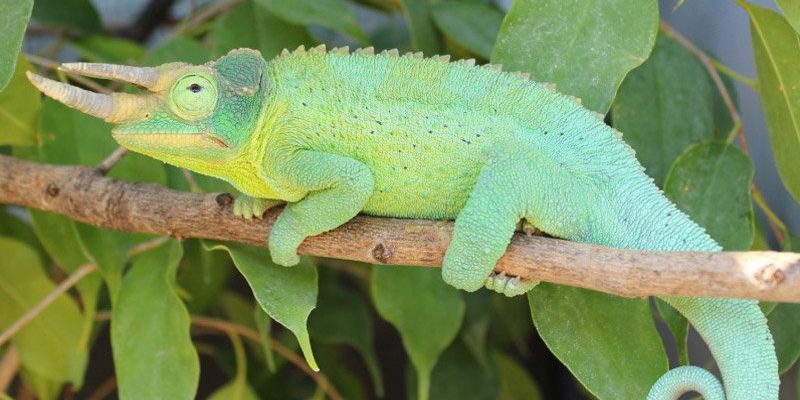
If you’re curious about the Jackson’s chameleon, you’re in for a treat. This little guy, native to East Africa, is not only visually striking but also fascinating in behavior. Identifying a Jackson’s chameleon requires a little attention to detail, so grab your coffee (or your notepad), and let’s break down the colorful world of this unique reptile.
Physical Characteristics of a Jackson’s Chameleon
The Jackson’s chameleon is easily distinguishable by its three distinctive horns on its head, which give it an almost mythical appearance. Picture a tiny dinosaur with these expressive horns that point forward, like a miniature triceratops.
These lizards are generally green or brown with vibrant blue, yellow, or orange spots that can change depending on the environment and mood. They can grow to about 10 to 15 inches long, making them a bit larger than your average desktop pet. Their skin is covered in small, bumpy scales, adding to their unique texture. When you spot one, notice how they often hang out in a relaxed pose, with their bodies contorted around branches as if they’re posing for a nature magazine.
Color Changes and Mood Indicators
One of the most fascinating things about the Jackson’s chameleon is its ability to change color. This transformation isn’t just for decoration; it’s a form of communication and temperature regulation. If a chameleon feels threatened, it might darken to blend into the shadows. On the flip side, a bright display can suggest it’s happy or trying to attract a mate.
You might be wondering how this color change works. Here’s the thing: Jackson’s chameleons possess special cells called chromatophores that contain different pigments. As these cells expand or contract, the lizard’s skin changes color. So, if you spot a chameleon that seems to light up in different shades, it’s not just a trick of the light; it’s their way of talking without words!
Habitat and Behavior
Now that you know what to look for physically, let’s chat about where you might find a Jackson’s chameleon in the wild. They thrive in moist, wooded areas like rainforests, usually up in the trees or shrubs. These lizards are not ground-dwellers; they prefer to keep a watchful eye from above, camouflaged among leaves and branches.
When observing their behavior, pay attention to how they *move*. Unlike other lizards that sprint or dash, Jackson’s chameleons are more deliberate and slow-moving. They use their long, prehensile tails to balance as they navigate their arboreal homes. If you see one flicking its tongue to catch insects, it’s like watching a little darting missile; their tongues can extend almost twice their body length!
Comparing Male and Female Jackson’s Chameleons
Did you know that male and female Jackson’s chameleons look quite different? This can be a big clue in identifying them. Males are typically more vibrant, showcasing brighter colors and those impressive horns. Think of them as the flashy peacocks of the lizard world.
Females, on the other hand, tend to be a bit more understated. They have a smoother appearance and lack those prominent horns. Their colors are usually muted, allowing them to blend in better with their surroundings—an essential trait when it comes to nesting and caring for young. If you find yourself staring at a pair, it’s easy to distinguish the male by its striking looks and behavior, like a proud rooster flaunting its feathers.
Where to Spot a Jackson’s Chameleon
If you’re eager to find a Jackson’s chameleon in the wild, locations like Kenya and Tanzania are prime spots. These regions are home to a variety of ecosystems that support these beautiful lizards. National parks like Mount Kenya National Park are excellent locations, as they offer dense vegetation where Jackson’s chameleons thrive.
Be mindful, though! While they’re stunning to observe, these creatures can be quite shy. Patience is key—find a quiet spot, and you might just see one lazily sunbathing on a branch. Often, you’ll hear their soft hissing sounds if they feel threatened or are trying to communicate, which adds to the excitement of spotting one in its natural habitat.
Common Misidentifications
You might run into other lizards that look somewhat similar to the Jackson’s chameleon, which is where things can get tricky. For example, you could confuse it with the Veiled Chameleon. While both are captivating, the Veiled Chameleon has a distinctive veil-like structure on its head and tends to be bulkier overall.
Additionally, Panther Chameleons are often larger and more colorful, with more diverse patterns. If you’re trying to identify a chameleon, pay close attention to the details, like the three horns of the Jackson’s chameleon. Those unique traits can help you avoid mix-ups and increase your reptile spotting success!
Identifying a Jackson’s chameleon isn’t just about knowing what they look like; it’s about appreciating their fascinating behavior and role in the ecosystem. Whether you’re out in the wild or observing a pet, remember to take your time and enjoy the experience. Each little detail, from their color changes to their slow, deliberate movements, adds to the magic of these creatures.
So next time you’re in a place where these chameleons roam, keep an eye out for their bright colors and unique features. With a little patience and knowledge, you’ll spot one in no time! Who knows, this might just spark a lifelong interest in reptile watching and conservation.

